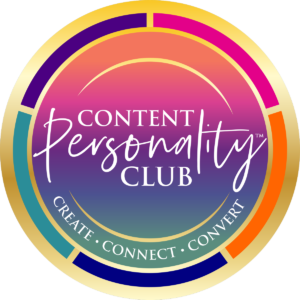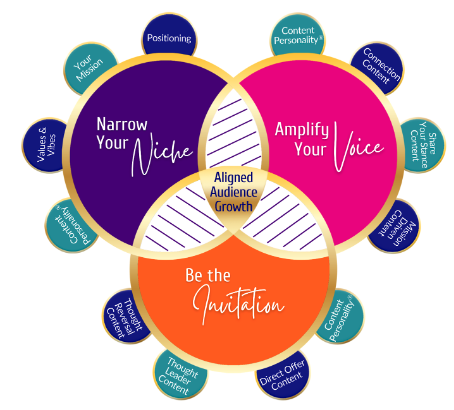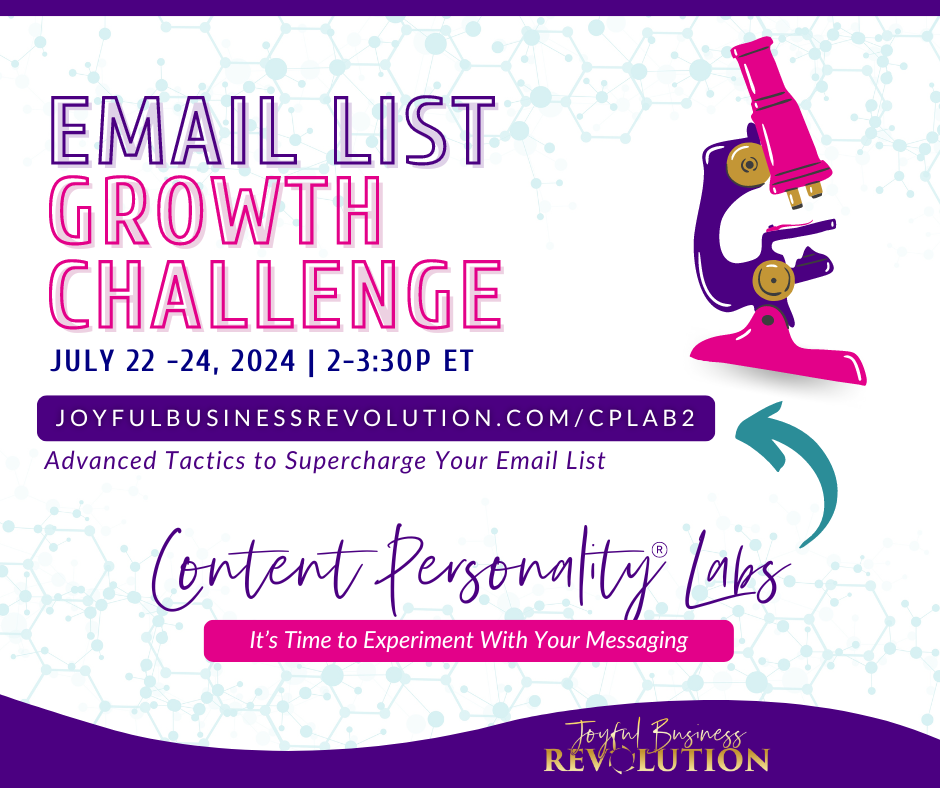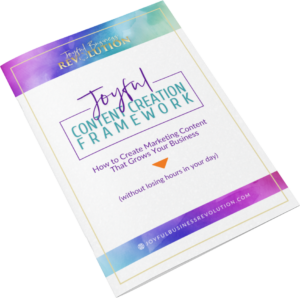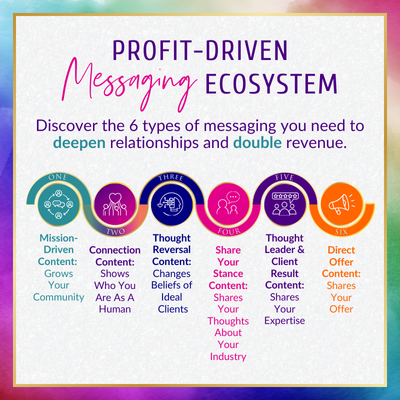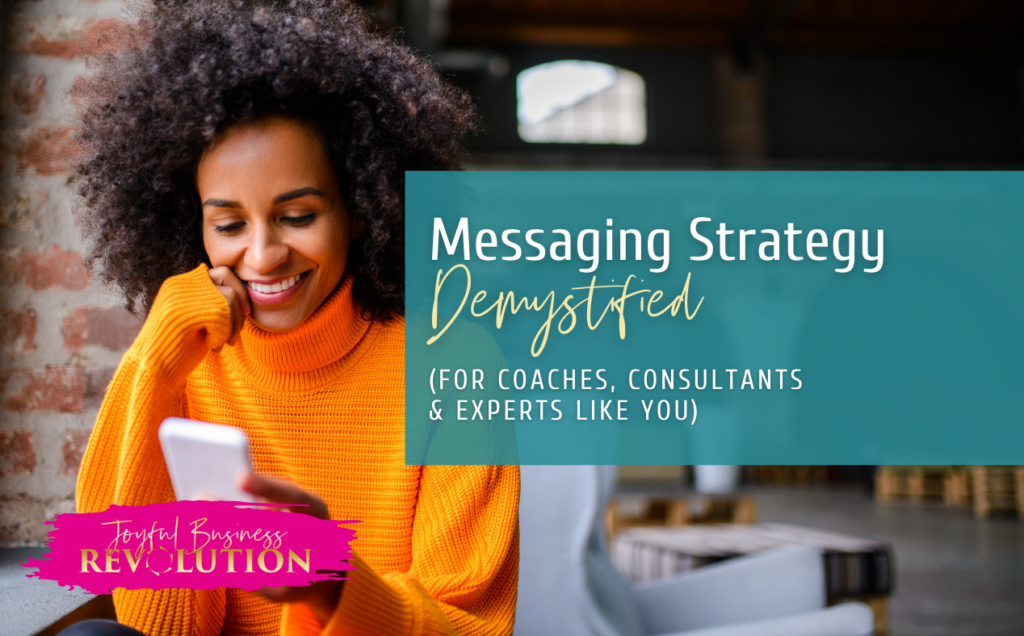 If you hear (or read) the words “messaging strategy” and wonder what that means or if it’s something you need to worry about as a solopreneur or small business owner, you’re not alone.
If you hear (or read) the words “messaging strategy” and wonder what that means or if it’s something you need to worry about as a solopreneur or small business owner, you’re not alone.
It’s easy to think that only bigger companies or corporations need message strategy—but here’s the truth—if you want customers, you need a way to attract and connect with them.
And that’s where your messaging strategy comes in—you’ve got to spend time figuring out:
- Who you serve
- How you help them
- Why it matters
When you do this well and tie it into your mission and buyer psychology, finding your target audience is much easier.
As a messaging strategist, I’ve devoted years to helping coaches, consultants, and other entrepreneurs create authentic messaging that helps them reach their goals. That’s when the magic happens, and people really start to gain traction.
Helping people find the right message is something that absolutely brings me joy, but it’s also one of the hardest things to do for your own business.
So, I’m taking the opportunity to break down my approach to brand messaging strategy in a series of six articles. Future articles will answer the most common questions I see about brand messaging pillars, positioning vs. messaging, your USP vs. your UVP, and strategies for authentic brand storytelling.
However, before we can look at all of the nuances, I want you to know two things:
#1: You cannot find your brand message using AI.
While I can see how it might be a great tool for brainstorming using the right strategies, using AI is a surefire way to kill your brand messaging. You are an original human with a unique perspective—AI simply regurgitates snippets that are already out there.
#2: Finding your message is just the first step in effective messaging and marketing.
You also need to share the message so your audience can find you. That means continuing to layer your message into your emails and other content to nurture your relationships and reinforce what it is you do.
When I talk about content creation and ongoing marketing, some people light up. Others get big eyes at the idea of it. But it doesn’t have to be overwhelming or complicated.
Amy and I created the Content Personality® Club to help business owners like you find joy in email marketing content creation (and provide the accountability to help you get it done). Get the details here.
What is Messaging Strategy?
You may have heard me say that your brand is what people say about you when you’re not around.
That means your messaging strategy should speak to how you communicate what you want to be known for—and what you want people to say about you behind your back.
What’s more, to truly stand out, you must be unforgettable.
To ensure people know what you stand for and what you do, you have to be consistent in all your communications.
After all, you want people to remember you for being incredible—not for confusing the hell out of them with different, often conflicting messages.
That’s one of the biggest messaging mistakes I see coaches and consultants make. They’ll test messaging for a while, and if it doesn’t gain traction quickly, they jump ship instead of fine-tuning it. And that’s usually right when it’s starting to “catch on” with your audience, when brand awareness among your potential customers was just starting to take hold!
By changing their communication approach dramatically, they wind up confusing the people who are #thisclose to saying yes.
So, how do you find the right message and know in your heart that it will work?
That’s quite literally the million-dollar question.
I can tell you this—in addition to clarifying what you do, who you do it for, and why it matters, your brand messaging must speak to your:
- Values: What do you stand for?
- Vision: What do you want to be known for?
- Voice: How do you want to make people feel?
And that’s when aligned audience growth happens. Here’s a graphic I often use to illustrate how all of this comes together.
What does this look like in my business?
At Joyful Business Revolution, our message focuses on three key pillars:
- Messaging rooted in buyer psychology
- Growing businesses sustainably with email marketing
- Joy
You’ll see that almost everything we build or do uses messaging that focuses on one or all of these factors. And, because we are SO consistent, people know how to introduce us.
Making Your Message A Movement
My entire approach to brand messaging can be summed up into the five words above: “Make Your Message a Movement.”
Here’s why.
When your message shares your mission, people want to get behind it. They buy what you stand for—or, at a minimum, they want to be a part of the movement and community you’re creating.
And that’s an important point—not everyone in your community will buy from you. Expecting a 100% conversion rate is unrealistic, and people who don’t buy still add tons of value and joy to your movement.
These are the four categories your messaging should attract:
- Future clients: These are the buyers—and realistically, they’re the smallest portion of your community.
- Collaborators: Some people become partners who support you in other ways, such as co-creating offers or events, co-marketing projects, or other cooperative efforts.
- Connectors: These people may never buy or collaborate, but they’ll introduce you to people who will.
- Cheerleaders: Your biggest supporters and superfans are here to help you spread the word about what you do and bring lots of joy to you and everyone in the community.
Ready to grow your email list and community and attract your four types of audience members? Join our free challenge July 22-24, 2024, and learn advanced tactics to supercharge your email list. Join us here!
Benefits of a Messaging Strategy
So many people Amy and I talk to know something is missing in their business. They’ve usually got a great offer and the right audience, but they’re having a hard time getting consistent sales.
When we ask about their messaging, they tell us they’ve never spent much time on it. So, we dig in to fill in the gaps to help them connect with their buyers and rediscover joy in their business.
While joy is the most important benefit, it’s far from the only one.
Coaches and consultants who base their marketing efforts on their messaging strategy also often benefit from:
- A Quicker Sales Cycle: By targeting messaging, your buyers can easily see the benefit of choosing you and your offer, partly because they love what you stand for.
- A Stronger Community: When your messaging is spot on, your community rallies around you, and you’re at the top of their minds when they need your offers—you don’t have to compete because you are their go-to. And they’ll refer you to their friends.
- Consistent Marketing: Even if you adjust your message for different marketing channels (and you should), because all of your marketing efforts fall under a single umbrella, they work together towards your goals.
- Efficient Marketing: No more spraying and praying. When you have an effective messaging strategy, you won’t have to change gears because you know you’re connecting with your target audience.
Spending time fine-tuning your messaging strategy should be a no-brainer and top priority…but what should your messaging strategy look like? And what goes into it? Let’s keep going.
Wondering about your messaging strategy and how to make it work for you? Set up a call with Amy and she can help you find the best solution.
Core Components of a Brand Messaging Strategy
If you ask 14 different messaging strategists what should go into your brand messaging strategy, you’ll probably get 14 different answers.
Some people talk about a huge 40-page document that might work well for a corporate messaging strategy, but isn’t realistic for most small businesses. Others provide an oversimplified version that might be helpful to you, but as you grow, it’s not nearly comprehensive enough to help your team represent you consistently.
What the document looks like is ultimately up to you. Some companies find a simple Google document is perfect because they can adapt it easily. Others prefer a beautifully designed PDF. Others prefer the middle ground of Canva or Google Slides.
I recommend starting simple, and then you can always add design elements to support your messaging. With that in mind, here are the core components of a brand messaging strategy so you can start creating yours.
Your Mission, Vision, and Story
If you’re not leading with your mission or goals, then it’s going to be harder to attract and nurture your community.
So, let me ask you a few questions:
- What is your life mission?
- Why does it matter to you? To your audience?
- What’s the story behind it?
You can start by filling in this sentence: My business supports my life mission by:_______.
Need an example?
Here’s mine:
My business supports my life mission by spreading messaging and marketing joy to business owners, so that they can deepen relationships and double revenue in their own businesses by sending one email per week.
Then, start diving into the story and your why.
There’s always a story…and it’s usually incredibly compelling. While you’ll eventually need to tighten up this portion of your messaging, getting started is as easy as answering these questions. I’d recommend you not try to be concise yet. Focus on getting as deep as you can for now to get to the heart of the story.
To continue developing your thoughts, you can try these ideas whenever you finish a thought:
- Ask yourself, “Why?” Then, keep asking and answering until you’ve gotten to the heart of it.
- Add the words “so that” after it to continue the sentence and go even deeper.
- Put your audience’s hat on and see if the thought makes sense. If not, clarify further.
Your Values
Some companies always believe in sharing their brand values as part of their messaging plan, while others keep them internal to help onboard team members and provide a lens for the rest of their messaging.
When finding and defining your values, consider asking yourself:
- What are your non-negotiables? What will you never sacrifice for business?
- How do you want to make people feel when interacting with your business?
- What do you dislike about your industry, and how do you want to be different?
There are some other exercises you can try, but I’ve found that answering these questions helps you get a head start on your values and keeps the process simpler and easier to follow.
Your Voice
Finding your brand voice is always a fun exercise. Since it’s how you express your values, you’ll explore at many similar questions as in the values section.
If you feel stuck, you can look at a list of brand adjectives that you want to describe your voice (and, for that matter, your values). However, I find that people often spend way too much time picking adjectives and not enough time working on and sharing their messaging.
Instead, my approach is usually to talk out questions like:
- What kinds of things do you want to say?
- What are some things you never want to do or say?
- How do you want to make people feel?
Your Aligned Audience
Buyer psychology plays a huge role in your messaging. A huge part of my work with clients relates to finding and aligning your audience.
What does that mean?
An aligned audience is aligned with your mission, and they know, like, and trust you.
So, while your vision, values, and voice are critical for setting the narrative you want people to share when you’re not around and attracting your people, you also have to know who those people are to attract them in the first place.
Whether you create detailed buyer personas or focus on things they’re saying, you can use these questions to drill down further:
- Who do you want to serve?
- Who are you currently attracting and serving?
- What’s different about who you want to serve?
- Where do they hang out?
- What are their biggest pain points?
- How do you solve their pain points?
- How do they talk about the problem and your solution?
Once you’ve defined your aligned audience, you can go back to your messaging for your business and your offers and tailor the outcomes and messaging to your audience.
Your Community
Defining the kind of community you want to build is an integral part of your messaging strategy because it helps you determine how you want to show up. Even though I have a thriving Facebook group, I do most of my community-building and nurturing via email.
Why?
Email is my love language because it frees me up to NOT be on social media 24/7.
Is your community part of your messaging strategy? Not always, but it’s easier to focus on building and talking about it when you define yours.
Where should you host your community—Facebook, Slack, Email, Substack, etc.? That depends on factors like your business, your audience, and your Content Personality®—or how you best show up.
Our Content Personality® Quiz is designed to help you understand how to use your natural strengths to create marketing content and maximize your time and energy. Take the quiz here!
Your Glossary
As your business grows, you will use terms that your audience may not understand. To help your growing aligned audience become insiders, I recommend creating a glossary of terms you can share with them early on.
Here are a few I always share with people I connect with:
Content Personality®: This is your unique delivery method for your messaging and marketing. Using your Content Personality® as your foundation helps you simplify your marketing so you attract aligned clients and sell in a way that FEELS good to you (and them!). And the quiz I shared above helps you zero in on this!
Different is Better: “Different is Better” in business means that the best way to ensure your success is to be different: to stand out from the crowd, not blend in.
Joyful Business Revolution™: A community that helps you grow a joyful and profitable business you love—where abundant time off is non-negotiable.
Your Messaging Shouldn’t Be Static
Even though your mission may not change, the market and your offers will probably shift as time passes. It’s a good idea to revisit your messaging and communications strategy periodically, especially if and when you notice a shift.
What’s Not Included
You’ve probably noticed the above list is a lot simpler than what many people talk about when defining messaging and marketing strategies. Namely, I didn’t talk much about Unique Value Proposition (UVP) or Unique Selling Proposition (USP) or anything in that category.
There’s a reason for that.
While they absolutely have value, they can also be a huge distraction. I often call things like this a “BFFD” (a big fat f***ing distraction) because if you spend too much time on this exercise and not enough time on taking action, you’ll miss out on actually growing your business.
The bottom line here is that finding your message is a critical first step in creating a joyful business—and that’s what my mission is all about.
Effective Messaging Strategy in Action: 5 Examples
Once you have an aligned audience, the most effective messaging strategy is consistency—repeating your message over and over. It may feel like a lot, but think Taylor Swift. She sings the same songs night after night, and she has hundreds of millions of raving fans who know what to expect from her shows.
So what’s the lesson?
Consistent brand messaging builds trust over time.
Here are a few examples of consistent brand messaging in action.
CocaCola
Coca-Cola isn’t really selling soda. If you look at its advertising, its messaging strategy backs this up—nearly every piece of content is about happiness, sharing, and refreshment. Its investor relations report shares, “The Coca-Cola Company’s purpose remains clear: To refresh the world and make a difference.”
However, consistent messaging can also be visual. Just think how weird it would be if you walked into a grocery store and the Coke cans were all green.
Dove
Dove sells body positivity and acceptance. The soaps, lotions, and creams are just the products that help people get there.
Nike
Nike’s brand message is about empowerment, hope, and love of sport. Sure, they sell plenty of athletic gear, but when you look at their messaging strategy, it’s about achieving your goals.
Harley Davidson
Harley is absolutely about the bike, but their messaging is about the lifestyle—they ultimately sell freedom.
Joyful Business Revolution™
Of course, I had to throw our messaging into this list, too. We’re all about joy, specifically ensuring that your business supports your life and brings you joy.
Finding and Following Your Messaging Strategy
Once your core messaging is in place, it’s time to spread key messages through all of your marketing channels—your email list, social media, and website. While content marketing is one of the biggest pain points for most coaches, consultants, and experts I talk with, it doesn’t have to be complicated.
I’ve developed a JOYFUL content creation approach that helps you simplify your content creation process, generate relevant and engaging content consistently, and significantly boost your online visibility and audience engagement. Get the framework here.
Would you like to dive deeper into your messaging–and learn how to use it to attract and nurture your audience?
Be sure to tune into our podcast to get our hot takes on messaging, email marketing, and other topics related to creating a business that brings you joy.
Want to learn more about our take on messaging strategy? Check out all the articles in our messaging series.
Here’s a complete list of the articles in this messaging series:
- Messaging Strategy Demystified (For Coaches, Consultants & Experts Like You)
- Using Brand Messaging Pillars to Guide Your Content
- A Masterclass in Messaging & Positioning for Coaches & Consultants
- Unique Value Proposition (UVP) versus Unique Selling Proposition (USP)
- 197 Brand Adjectives to Describe Your Brand [Sorted by Category]
- Authentic Brand Storytelling. For Everyone.

